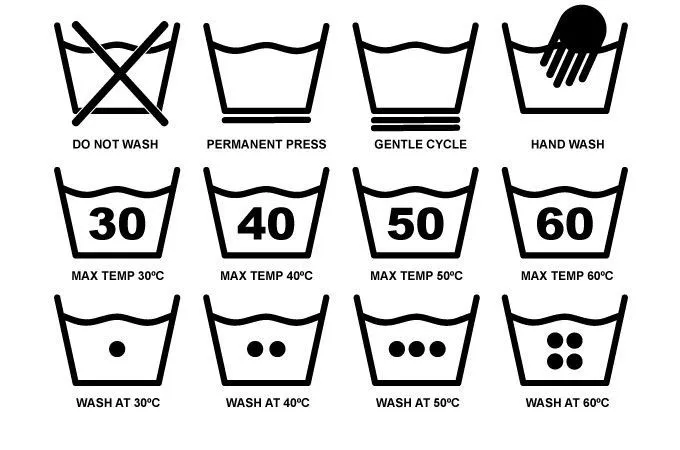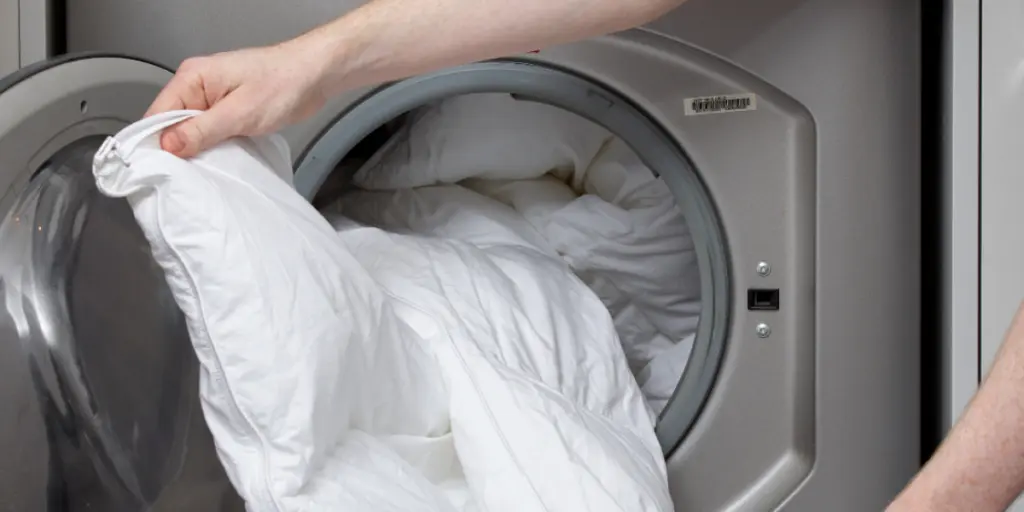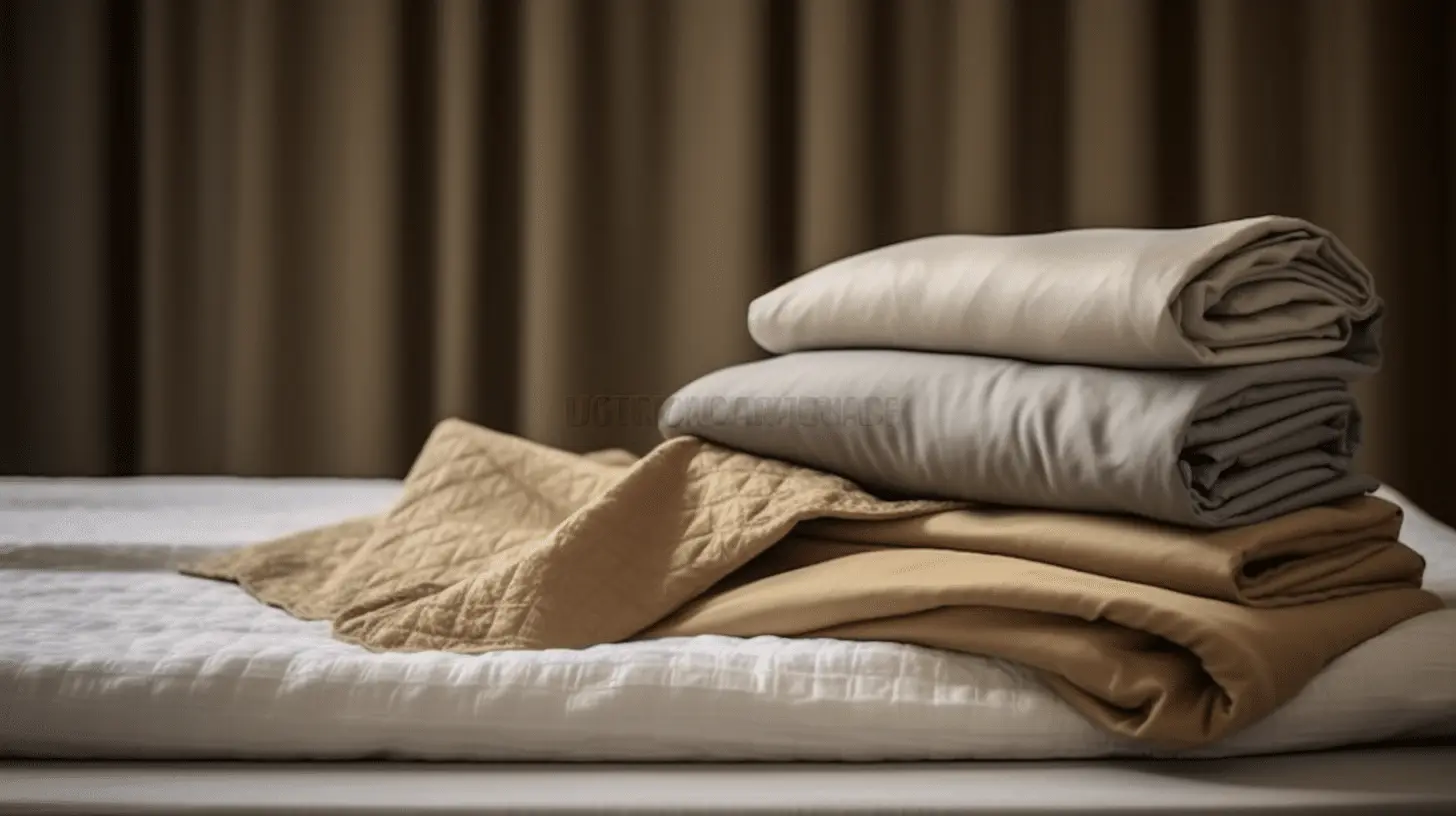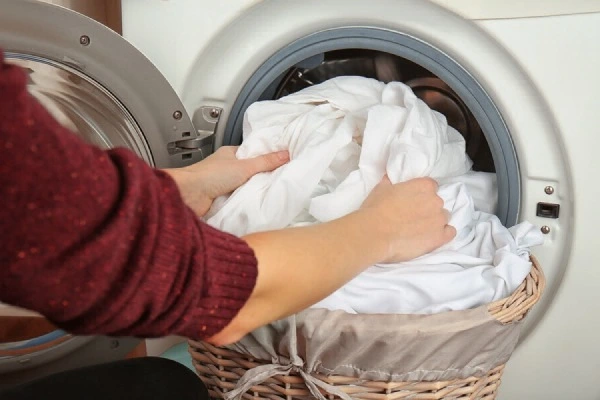Maintaining your bedding is crucial for ensuring a restful night’s sleep; however, bedding care can be a laborious task with the sheer amount of materials and types of bedding that require a special maintenance routine, but it’s essential to have a regular cleaning routine for your bedding that is doable for you and satisfactory in terms of final results.
Bedding Care Principles
Understanding and adhering to the care instructions of your bedding is paramount to ensuring its longevity, as is knowing how to wash your bedding properly. Here's a breakdown of how often various bedding items should be washed and the symbols to look out for on care labels:
Frequency of Washing
- Sheets and pillowcases: Once a week
- Comforters and bedspreads: Every 3–6 months
- Mattress protectors: Every 2–3 months
- Bed pillows: Every 6–12 months
Care Label Symbols Explained

- Washing: A bucket symbol with dots indicating temperature. Two dots for a normal wash cycle and six dots for a gentle cycle at 60°C/140°F.
- Bleaching: A triangle, with a crossed-out triangle indicating no chlorine bleach.
- Drying: A square box with a circle inside for machine drying at low to moderate heat. A square with a circle and an arc at the bottom for dry flat.
- Ironing: An iron symbol with dots for temperature. Three dots for very hot iron, two dots for hot iron, and one dot for warm iron.
- Professional Cleaning: A circle represents professional cleaning, with a letter inside indicating the required solvent and processes.
Effective Washing Techniques for Various Bedding Materials
Bedding Cleaning Tips
- Always check the care label: This label will provide information on how to clean bedding, the recommended washing temperature, whether or not the bedding can be machine washed, and any other special care instructions. By following these guidelines, you can avoid damaging your bedding and keep it looking its best for years to come.
- Separate lights and darks: One of the most crucial bedding rules is to separate the lights and darks. This is especially important with colored or patterned bedding, as colors can bleed and transfer onto other fabrics. By separating your lights and darks, you can prevent this from happening and keep your bedding looking vibrant and fresh.
- Skip the harsh chemicals: When it comes to selecting a detergent for washing your bedding, it is best to choose a mild and gentle option. Harsh chemicals can not only damage your bedding, but they can also irritate your skin and cause allergies.
- Drying matters: After ensuring your bedding is thoroughly washed, the next steps in bedding care involve drying and ironing to maintain a pristine condition.
- Don't overload the washer: Don’t overstuff the washing machine to ensure a thorough clean, as your bedding won’t get properly washed if your washing machine is overloaded.
Material-Specific Tips
- Cotton: Cotton tolerates hot water, which is ideal for killing germs. Can be washed with detergent and bleach.
- Polyester: With polyester and polyester blends, avoid using cold water and opt for warm water on a gentle cycle.
- Silk: Go for a gentle cycle with cold water and a delicate fabric detergent, and avoid machine drying.
- Linen: Use cold or lukewarm water on a gentle cycle with a mild detergent without bleach or fabric softeners.
- Bamboo: Opt for a cold water wash with a mild and preferably eco-friendly detergent.
Temperature and Cycle Guide

- Warm Water (40–60°C or 100–140°F): Cotton, linen, and polyester on a regular cycle.
- Cold Water: Delicate fabrics like silk or satin on a gentle cycle.
- Hot Water (130–150°F or 54–66°C): White cotton or linen for stain and bacteria removal.
Drying and Ironing Tips
Drying Tips
- Tumble Dry: Always use a low-temperature setting; also, adding wool dryer balls can shorten drying time and naturally soften the bedding.
- Manual Timing: Set the dryer manually to finish while the bedding is slightly damp. This reduces creasing and makes ironing easier.
- Outdoor Drying: Whenever possible, hang sheets to dry outside. The sun acts as a natural disinfectant and can help freshen and brighten your bedding.
Ironing Tips
Fabric Temperature: Iron sheets according to the fabric's specific needs; also, avoid ironing elastic parts of fitted sheets to prevent damage.
Ironing Board Use: Employ a full-size ironing board for best results, as ironing sheets off the bed ensures no damage is done to the mattress and achieve a smoother finish.
Efficiency Strategies:
- Iron bed linen before it's completely dry to ease the ironing process and protect your iron from limescale buildup.
- Focus on ironing the top quarter of the sheets and pillowcases for a quick refresh and a tidy appearance.
- For a minimal-effort approach that still offers a polished look, concentrate on pillowcases and the visible parts of the top bedding.
Stain Removal Techniques
Immediate Action
Treat stains as soon as they occur. Use a dull knife or spoon to gently scrape off any excess.
Pre-Treatment
Apply a stain remover or a mixture of water and detergent directly onto the stain. For tougher stains, a paste of baking soda and water can be effective.
Specific Stains Removal
- Blood: Blood stains can be tricky to remove but one of the best methods to do so is by soaking the stain in cold water, then dabbing it with hydrogen peroxide.
- Makeup: With makeup stains, you can apply a mixture of water and liquid dish detergent.
- Coffee: Mix water, liquid dish detergent, and white vinegar, then soak the stained area.
- Sweat: With sweat stains, it is advisable to pre-treat the affected area with a stain remover before washing in hot water.
- Wine: Wine stains should be treated immediately by blotting the stain with a clean cloth and applying a mixture of water and vinegar.
- Grease: Sprinkle baking soda or cornstarch on the stain and let it sit for a few minutes before brushing it off and washing it as usual.
Bedding Storage Tips

Proper Folding
Neatly fold sheets and bedding to prevent creases, and you can also use breathable storage bags or containers to keep them in a cool, dry place.
Protection
Use bed pillow protectors and mattress toppers to shield your bed pillows and mattress against dust mites and spills.
Freshness
Wash your bedding before storing it, and occasionally freshen up your bedding with natural odor-eliminating sprays like white vinegar or baking soda. Essential oils can also add a pleasant scent.
FAQs
What are the general guidelines for how to wash bed sheets?
For optimal care and clean bedding, the best way to wash bed sheets and duvet covers is to wash them separately to avoid damage from zippers or hooks found on other garments. Use gentle wash cycles and mild detergents to prevent fabric damage, as fast cycles and bleach-based products can be harsh on bedding materials.
How often should I wash my bedding? And what cycle is recommended for most materials?
Bedding should be washed weekly or biweekly with a high-quality laundry detergent. The default water temperature should be cold, and the bedding should be washed on the “normal” cycle without overloading the washing machine to ensure thorough cleaning.
What temperature should I wash bed sheets at?
To effectively kill bacteria, bed sheets should be washed at a warm temperature. A 40-degree Celsius wash is sufficient, but a 60-degree Celsius wash is more effective at eliminating germs, especially if someone in the household has been sick.
What steps should be taken for the care and maintenance of bedspreads?
To maintain a bedspread, it's best to wash it before it becomes overly dirty. Use a spray prewash product for any spots or stains. Test the bedspread's colorfastness by dipping a corner into the detergent solution; if the color runs, opt for dry-cleaning instead.
Are fitted and flat sheets cared for in the same way?
Fitted and flat sheets although similar in purpose, they do require slightly different care. Fitted sheets have elasticized corners that hug the mattress, ensuring a snug fit. As a result, they are prone to shrinking if washed in hot water or dried on high heat. It is recommended to wash fitted sheets in cool or warm water and to air-dry them or use a low-heat setting on the dryer. Flat sheets, on the other hand, do not have elasticity and are therefore less likely to shrink. They can be washed and dried using regular settings.
How do you make your bedding clean and tidy, like in hotels?
If you want to achieve the same level of clean bedding and tidiness as hotel bedding, it is important to establish a regular cleaning routine for your bedding. This includes washing your sheets, pillowcases, and duvet covers every week. Additionally, using the hospital corner sheet tucking technique can make a big difference.
How do I wash percale sheets?
It is recommended to wash percale sheets in cold or warm water on a gentle cycle. Use a mild detergent and avoid harsh chemicals or bleach. To maintain their softness, avoid using fabric softeners. Once washed, tumble dry on low heat or air dry to prevent shrinkage.
What are the benefits of clean bed sheets?
Clean sheets provide a hygienic environment, minimizing the risk of skin infections, allergies, and respiratory problems caused by dust mites, dirt, and sweat. Regularly washing bed sheets also eliminates unpleasant odors, ensuring a fresh and pleasant sleeping experience. Secondly, clean sheets promote better sleep quality by reducing discomfort and improving overall relaxation, so it's essential to know how to wash bed covers, what you wash sheets on, and how to clean bedding.
Can I wash bed sheets with towels?
Yes, it is generally safe to wash bed sheets with towels. Both bed sheets and towels are made of similar materials and can be washed together without causing any damage or harm. However, one of the most important bedding tips is to consider the color and fabric of the bed sheets and towels before washing them together.
Conclusion
Regularly washing and maintaining your bedding is not just about preserving its freshness; it's a crucial aspect of bedding care that ensures a restful night's sleep and maintains overall hygiene, so make sure that your bedding is properly maintained in a way that won’t damage it or decrease its performance in the future.
Dom Abraham
As the lead content writer at Sleepiverse. Dom pours his heart into writing mattress reviews, bedding product reviews, and medically-reviewed health articles. Dom is from Portugal and likes to spend his free time writing on the beach as it gives him a sense of comfort. Aside from writing mattress reviews in front of the soothing beach view, Dom likes to experiment with new amazing food ideas.


